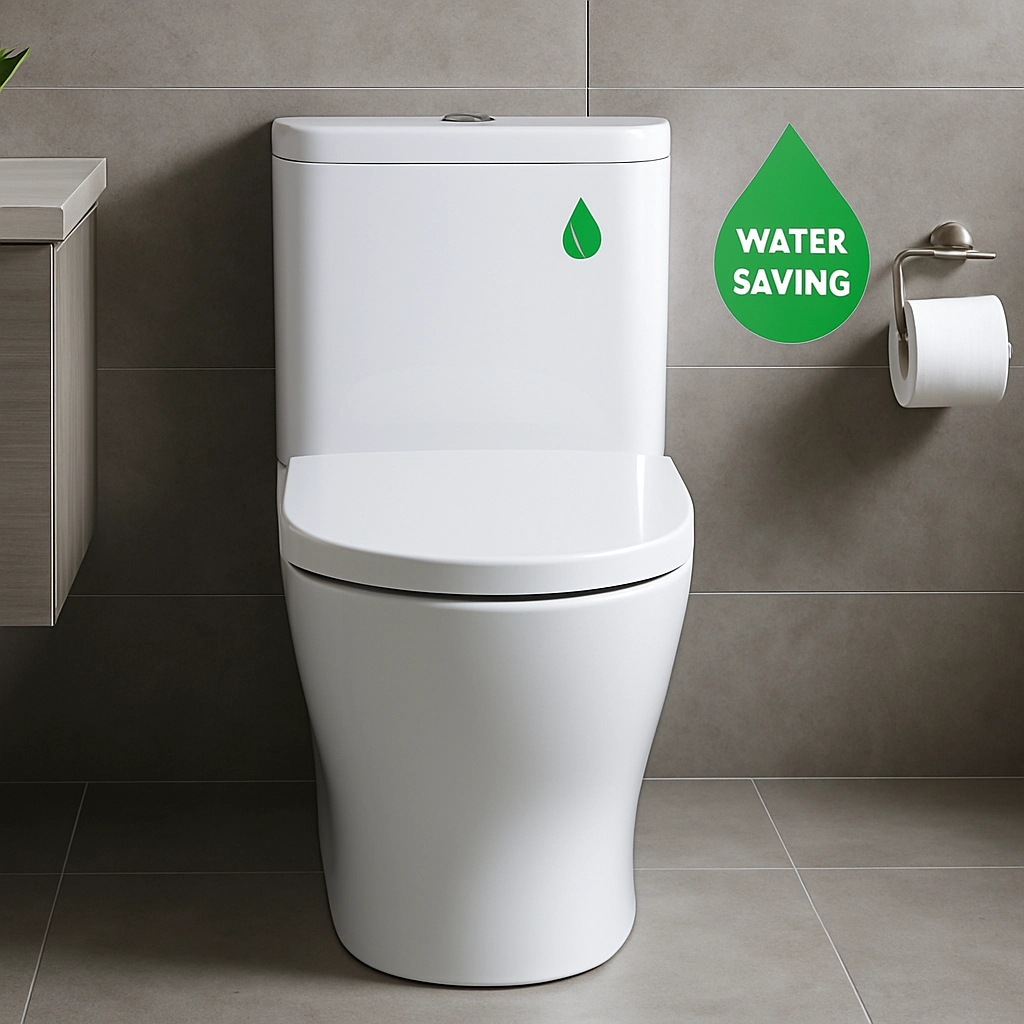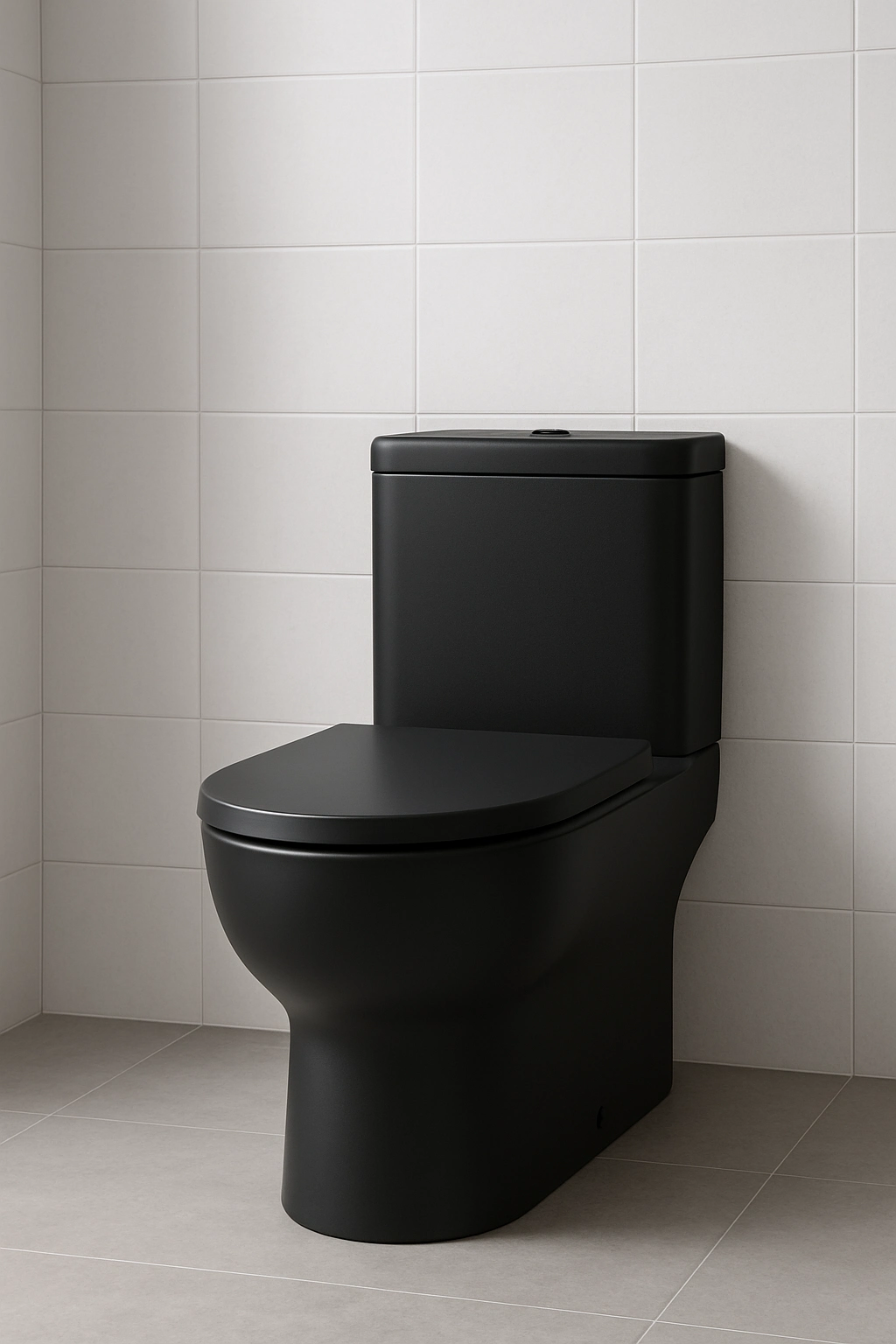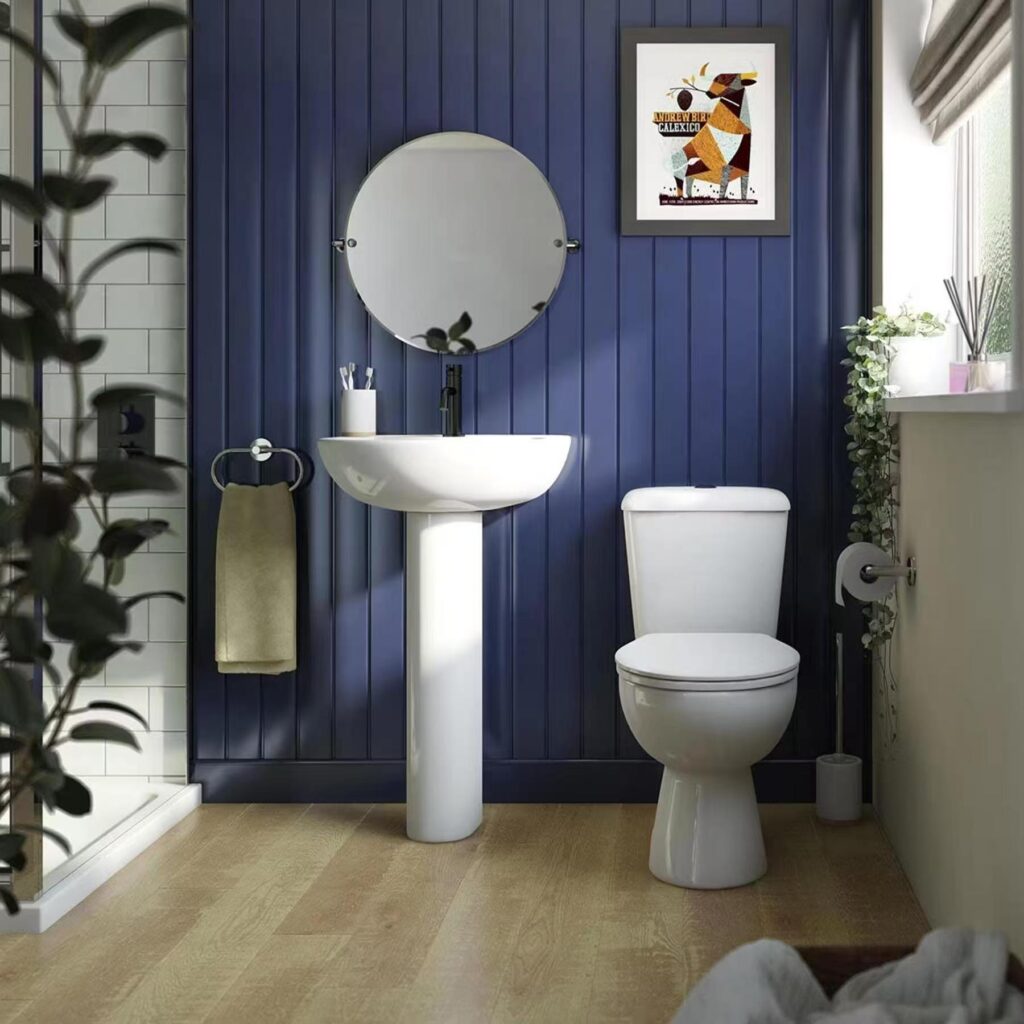Bekendstelling
In an era where water scarcity is becoming increasingly prevalent, the humble toilet has emerged as an unexpected hero in the fight for sustainability. Traditional toilets, once water-guzzling necessities, now stand at the forefront of eco-innovation, offering solutions that not only conserve our most precious resource but also redefine home comfort.
Today’s eco-friendly toilets are far more than just water-savers; they’re technological marvels that blend environmental consciousness with smart features. From dual-flush precision that slashes water usage by up to 60% to composting toilets that transform waste into valuable resources, these advancements are revolutionizing how we think about bathroom sustainability. But the benefits don’t stop at water conservation—modern eco-toilets are also raising the bar for hygiene and user experience, proving that going green doesn’t mean sacrificing comfort.
As a Technical Sales Manager at MFBath, I’ve witnessed firsthand how these innovations are reshaping the sanitary ware industry. Our CE-certified products, including smart toilets and water-efficient models, are meeting the growing demand for sustainable bathroom solutions without compromising on quality or performance. Whether you’re a green builder looking to meet stringent environmental standards or a homeowner aiming to reduce your ecological footprint, understanding the latest eco-friendly toilet features is crucial. Let’s dive into the top advancements that are making waves in sustainable home design and explore how they can benefit both your wallet and the planet.
What Makes a Toilet Eco-Friendly?
When it comes to sustainable home design, every element counts – including the humble toilet. But what exactly makes a toilet eco-friendly? Let’s dive into the world of sustainable sanitation and explore the features that set these water-wise wonders apart from their traditional counterparts.
Defining Eco-Friendly Toilets: Core Principles of Sustainability
At its core, an eco-friendly toilet is designed to minimize environmental impact without compromising functionality. These innovative fixtures embody several key principles:
- Water Conservation: Using significantly less water per flush
- Energy Efficiency: Reducing energy consumption in manufacturing and operation
- Sustainable Materials: Incorporating recycled or renewable materials
- Durability: Lasting longer to reduce waste and replacement frequency
By adhering to these principles, eco-friendly toilets “go the extra mile” in supporting sustainable living practices.
“Eco-friendly toilets combine water conservation, energy efficiency, and sustainable materials to significantly reduce environmental impact while maintaining high performance.”
Environmental Impact: Traditional vs. Eco-Friendly Models
To truly appreciate the benefits of eco-friendly toilets, it’s essential to compare their environmental impact with traditional models:
| Kenmerk | Tradisionele toilet | Eco-Friendly Toilet | Environmental Benefit | Annual Savings* |
|---|---|---|---|---|
| Water Usage (per flush) | 6-7 gallons | 1.28 gallons or less | Reduced water consumption | ~13,000 gallons |
| Flush Mechanism | Single flush | Dual flush | Customized water use | ~3,000 gallons |
| Materials | Standard porcelain | Recycled/sustainable materials | Reduced raw material extraction | N/A |
| Lifespan | 10-15 years | 20-30 years | Less frequent replacement | Varies |
| Energy Usage | Standard | Low-energy manufacturing | Reduced carbon footprint | ~100 kWh |
*Estimated savings for a household of four. Actual savings may vary based on usage patterns and local utility rates.
Role of Certifications in Green Building
Certifications play a crucial role in identifying truly eco-friendly toilets. Two key certifications to look for are:
- WaterSense: A U.S. Environmental Protection Agency (EPA) program that certifies water-efficient products
- CE: European Conformity marking, ensuring products meet EU safety, health, and environmental protection requirements
These certifications not only guide consumers but also help builders and designers meet green building standards. At MFBath, we’re proud to offer CE-certified eco-friendly toilets that meet these stringent environmental standards, providing peace of mind for eco-conscious customers and green builders alike.
Market Trends Driving Sustainable Toilet Solutions
The demand for eco-friendly toilets is on the rise, driven by several key factors:
- Increasing environmental awareness among consumers
- Stricter water conservation regulations in many regions
- Rising utility costs, making water-saving features more attractive
- Growing popularity of green building certifications (LEED, BREEAM, etc.)
Interestingly, there’s a growing trend of eco-friendly toilets being marketed not just for their environmental benefits, but also for their modern aesthetics and innovative features. This shift is setting them apart from traditional models and appealing to a broader range of consumers who value both sustainability and style.
As we continue to prioritize sustainability in our homes and buildings, eco-friendly toilets stand out as a simple yet impactful way to reduce our environmental footprint. By choosing water-saving toilets and sustainable toilet solutions, we’re not just conserving resources – we’re investing in a greener future, one flush at a time.

Water-Saving Technologies in Eco-Friendly Toilets
As we become more conscious of our environmental impact, water conservation has taken center stage in home design. Eco-friendly toilets are at the forefront of this movement, incorporating innovative technologies that significantly reduce water usage without compromising performance. Let’s explore the cutting-edge features that make these toilets a “spelwisselaar” in sustainable bathroom solutions.
How Dual-Flush Toilets Work: Mechanics and Water Savings
Dual-flush toilets are a cornerstone of water-saving technology in eco-friendly bathroom fixtures. These ingenious devices offer two flushing options:
- A low-volume flush for liquid waste (typically 0.8 to 1.1 gallons)
- A full-volume flush for solid waste (around 1.6 gallons)
This clever design allows users to choose the appropriate flush volume, significantly reducing water consumption compared to traditional single-flush toilets.
“Dual-flush toilets can save up to 68% of water compared to older, inefficient models, making them a powerful tool in water conservation efforts.”
Low-Flow Toilets: Efficiency Without Compromising Performance
Low-flow toilets take water efficiency to the next level. These eco-friendly toilets use 1.28 gallons per flush or less, compared to older models that use 3.5 to 7 gallons. Despite using less water, modern low-flow toilets maintain excellent flushing power through innovative design features:
- Pressure-assisted flushing systems
- Optimized bowl design for efficient waste removal
- Larger trapways to prevent clogging
At MFBath, our range of WaterSense-certified dual-flush and low-flow toilets exemplify these water-saving technologies, offering homeowners and builders an ideal solution for reducing water bills and meeting sustainability goals.
WaterSense Certification: Standards and Benefits
The WaterSense label, awarded by the U.S. Environmental Protection Agency (EPA), is a mark of excellence for water-efficient products. For a toilet to earn this certification, it must:
- Use no more than 1.28 gallons per flush
- Meet rigorous performance standards
- Provide equal or superior performance compared to regular models
Choosing a WaterSense-certified toilet ensures you’re getting a product that saves water without sacrificing functionality.
Comparing Water Usage: Eco-Toilets vs. Traditional Models
To truly appreciate the impact of water-saving toilets, let’s look at a detailed comparison:
| Toilet tipe | Average Gallons per Flush | Annual Water Usage* | Annual Water Savings** | Estimated Annual Cost Savings*** |
|---|---|---|---|---|
| Pre-1980s Model | 5-7 | 33,580 gallons | N/A | N/A |
| 1990s Standard | 3.5 | 21,000 gallons | 12,580 gallons | $37.74 |
| Current Standard | 1.6 | 9,600 gallons | 23,980 gallons | $71.94 |
| WaterSense Certified | 1.28 | 7,680 gallons | 25,900 gallons | $77.70 |
| Dual-Flush (Average) | 1.1 | 6,600 gallons | 26,980 gallons | $80.94 |
* Based on an average of 4 flushes per person per day in a 4-person household. ** Compared to pre-1980s model. *** Based on average U.S. water rate of $3 per 1,000 gallons.
This comparison clearly demonstrates how much water an eco toilet can save. The annual water savings and cost benefits make a compelling case for upgrading to a water-saving toilet.
As we’ve seen, water-saving technologies in eco-friendly toilets offer significant benefits in terms of conservation and cost savings. From dual-flush systems to low-flow innovations, these advancements are reshaping our approach to bathroom design and water usage.
Interestingly, there’s a growing trend of marketing eco-friendly toilets not just for their environmental benefits, but also for their modern aesthetics and innovative features. This shift is setting them apart from traditional models, appealing to consumers who value both sustainability and style in their home design choices.

Composting Toilets: Transforming Waste into Resources
As we explore innovative sustainable toilet solutions, composting toilets stand out as a unique eco-friendly toilet option that goes beyond water conservation. These ingenious systems transform human waste into valuable compost, offering a “closed-loop” approach to sanitation that’s particularly appealing for off-grid homes and eco-conscious consumers.
How Composting Toilets Work: Aerobic Decomposition Process
Composting toilets operate on a simple yet effective principle: harnessing the power of aerobic decomposition. Here’s how the process unfolds:
- Waste Collection: Human waste and often a carbon-rich material (like sawdust) are deposited into a composting chamber.
- Aeration: The chamber is designed to allow air flow, promoting aerobic bacterial activity.
- Decomposition: Bacteria break down the waste over time, reducing its volume and eliminating pathogens.
- Compost Production: The end result is nutrient-rich compost that can be safely used in non-edible gardens.
“Composting toilets can reduce household water usage by up to 30%, while producing valuable, nutrient-rich compost as a byproduct of waste management.”
Benefits for Off-Grid and Sustainable Homes
Composting toilets offer several advantages that make them particularly suitable for off-grid living and eco-conscious households:
- Water Conservation: They require no water for flushing, saving thousands of gallons annually.
- Energy Efficiency: Most models operate without electricity, perfect for remote locations.
- Nutrient Recycling: The resulting compost can enrich soil, closing the nutrient loop.
- Reduced Environmental Impact: Minimizes water pollution and strain on septic or sewage systems.
Addressing Sanitation Concerns: Are Composting Toilets Hygienic?
A common question about composting toilets is their hygiene. When properly maintained, these systems are indeed sanitary. Here’s why:
| Concern | Composting Toilet Solution | Effectiveness | Comparison to Traditional Toilets | User Maintenance Required |
|---|---|---|---|---|
| Odor Control | Ventilation systems and carbon additives | Baie hoog | Often better than traditional toilets | Laag – Adding carbon material regularly |
| Pathogen Elimination | Extended composting time (1-2 years) | Hoog | Comparable when properly managed | Medium – Ensuring proper composting time |
| Insect Prevention | Sealed containers and proper ventilation | Hoog | Similar to traditional toilets | Laag – Regular checks for proper sealing |
| Cross-Contamination | Separate storage of finished compost | Baie hoog | Lower risk than some septic systems | Medium – Proper handling of finished compost |
| Overall Cleanliness | Regular cleaning of toilet area | Hoog | Comparable to traditional toilets | Similar to traditional toilets |
Installation and Maintenance Considerations
While composting toilets offer numerous benefits, they do require some specific considerations for installation and maintenance:
- Space Requirements: Most models need room for a composting chamber, either directly below or nearby.
- Ventilation: Proper airflow is crucial for odor control and decomposition.
- Regular Maintenance: Adding carbon material, managing moisture levels, and removing finished compost.
- Local Regulations: Check local building codes and health regulations before installation.
As a supplier of innovative toilet solutions, MFBath recognizes the growing interest in composting toilets. While our current lineup focuses on water-efficient models, we’re keenly observing the market trends towards more sustainable options, including composting systems. This aligns with the increasing demand for off-grid building solutions and eco-friendly home designs.
Interestingly, there’s a growing trend of marketing eco-friendly toilets not just for their environmental benefits, but also for their modern aesthetics and innovative features. This shift is setting composting toilets and other sustainable models apart from traditional options, appealing to a broader range of environmentally conscious consumers who don’t want to compromise on style or functionality.
As we continue to innovate in the sanitary ware industry, composting toilets represent an exciting frontier in sustainable bathroom solutions. Whether for off-grid homes, eco-resorts, or environmentally conscious urban dwellers, these systems offer a unique approach to turning waste into a valuable resource.

Smart Toilet Features for Eco-Conscious Living
The future of bathroom technology is here, and it’s revolutionizing the way we think about eco-friendly toilets. Smart toilets are not just about luxury; they’re about combining cutting-edge features with environmental responsibility. Let’s explore how these high-tech marvels are transforming our bathrooms into “eco-powerhouses” of efficiency and cleanliness.
Integrated Bidet Fittings: Reducing Toilet Paper Use
One of the most significant eco-friendly features of smart toilets is the integrated bidet. These water-saving toilets with built-in bidets offer several benefits:
- Reduced toilet paper consumption
- Improved personal hygiene
- Decreased plumbing issues related to excess paper use
- Lower environmental impact from paper production and disposal
“Smart toilets with integrated bidets can reduce toilet paper use by up to 80%, significantly lowering both household costs and environmental impact.”
Self-Cleaning Nozzles and Stain-Resistant Materials
Modern eco-friendly toilets are designed with cleanliness and efficiency in mind:
- Self-cleaning nozzles use UV light or electrolyzed water for sanitization
- Stain-resistant materials reduce the need for harsh cleaning chemicals
- Rimless bowl designs eliminate hard-to-clean areas
These features not only maintain hygiene but also reduce water and chemical usage associated with cleaning.
Smart Features: Heated Seats, Sensors, and Remote Controls
Smart toilets come packed with features that enhance both comfort and efficiency:
| Kenmerk | Functionality | Eco-Benefit | User Benefit | Energy Impact |
|---|---|---|---|---|
| Verhitte sitplekke | Adjustable temperature settings | Reduces heating needs in bathrooms | Enhanced comfort | Low (uses 15-25 watts on average) |
| Automatic Sensors | Detect user presence and flush accordingly | Prevents unnecessary flushing | Hands-free operation | Minimal (battery-operated in many models) |
| Remote Controls | Adjusts bidet, seat temperature, and flush settings | Optimizes water and energy use | Personalized experience | Negligible |
| LED Night Lights | Soft illumination for nighttime use | Reduces need for bright bathroom lights | Improved safety and convenience | Very low (typically 0.5-1 watt) |
| Automatic Deodorizers | Activates to neutralize odors | Reduces use of air fresheners | Maintains fresh bathroom environment | Low (uses small fan, about 5 watts) |
Balancing Luxury with Environmental Responsibility
While smart toilets offer luxurious features, they’re designed with sustainability in mind:
- Precision water usage in bidet functions
- Energy-efficient heating elements
- Low-flow flushing options
- Use of recycled materials in manufacturing
At MFBath, our smart toilet range exemplifies this balance, combining eco-friendly features with modern aesthetics. These environmentally friendly bathroom products appeal to homeowners seeking premium, sustainable bathroom upgrades without compromising on style or functionality.
The growing trend of marketing eco-friendly toilets for both their environmental benefits and innovative features is reshaping consumer expectations. Smart toilets are no longer just about water conservation; they’re about creating a comprehensive eco-conscious bathroom experience that aligns with modern living standards.
As we continue to innovate in the sanitary ware industry, smart toilets represent the cutting edge of environmentally responsible bathroom design. They offer a glimpse into a future where luxury and sustainability coexist, providing comfort, hygiene, and efficiency while minimizing environmental impact.

Choosing the Right Eco-Friendly Toilet for Your Home
Selecting the perfect eco-friendly toilet for your home involves more than just water efficiency. It’s about finding a balance between environmental impact, cost-effectiveness, and your specific needs. Let’s dive into the key factors to consider when making this important decision for your “green bathroom makeover”.
Cost Analysis: Upfront Investment vs. Long-Term Savings
While eco-friendly toilets may have a higher initial cost, their long-term savings are significant:
| Toilet tipe | Average Upfront Cost | Jaarlikse waterbesparing* | 10-Year Water Cost Savings** | Average Lifespan |
|---|---|---|---|---|
| Standaard toilet | $100 – $300 | N/A | N/A | 15-30 years |
| Basic Eco-Friendly Toilet | $200 – $ 400 | $70 – $100 | $700 – $1,000 | 20-30 years |
| Dual-Flush Toilet | $250 – $500 | $100 – $130 | $1,000 – $1,300 | 25-35 years |
| Smart Eco-Friendly Toilet | $ 400 – $1,000+ | $120 – $150 | $1,200 – $1,500 | 20-30 years |
| Composting Toilet | $900 – $2,000+ | $140 – $200*** | $1,400 – $2,000*** | 20-30 years |
* Based on average U.S. household water usage and rates. ** Not accounting for potential water rate increases. *** Includes both water savings and reduced sewage costs.
“Investing in an eco-friendly toilet can lead to substantial water and cost savings over time, with some models paying for themselves within 5-7 years through reduced utility bills.”
Installation Requirements for Different Toilet Types
Consider these installation factors when choosing your eco-friendly toilet:
- Standard Eco-Friendly Models: Generally, a straightforward swap with existing plumbing.
- Dual-Flush Toilets: May require minor plumbing adjustments.
- Smart Toilets: Often need both plumbing and electrical connections.
- Composting Toilets: Require significant changes, including ventilation systems.
At MFBath, we offer customizable, CE-certified eco-friendly toilets that cater to various installation scenarios, ensuring a smooth transition for both new constructions and retrofits.
Key Certifications to Look For: CE, WaterSense, and ADA Compliance
When selecting an eco-friendly toilet, look for these important certifications:
- CE Marking: Ensures compliance with European health, safety, and environmental protection standards.
- WaterSense Label: Indicates water efficiency and performance standards set by the EPA.
- ADA Compliance: Guarantees accessibility for individuals with disabilities.
MFBath’s range of eco-friendly toilets meets these critical certifications, offering peace of mind for green builders and homeowners alike.
Tips for Green Builders and Homeowners: Procurement Checklist
Use this checklist when selecting the best eco-friendly toilet for your project:
- Water Efficiency: Look for models using 1.28 gallons per flush or less.
- Flush Performance: Check for MaP (Maximum Performance) testing scores.
- Material Durability: Consider toilets made with sustainable or recycled materials.
- Ease of Cleaning: Choose models with smooth, easy-to-clean surfaces.
- Compatibility: Ensure the toilet fits your bathroom’s rough-in dimensions.
- Warranty: Look for products with comprehensive warranty coverage.
- Additional Features: Consider options like dual-flush mechanisms or bidet functionality.
As you navigate the world of eco-friendly home upgrades, remember that choosing the right toilet is about more than just water savings. It’s an opportunity to blend environmental responsibility with modern aesthetics and innovative features.
The growing trend in eco-friendly toilets isn’t just about being green; it’s about elevating your entire bathroom experience. From sleek designs to smart features, these modern marvels are setting new standards in both sustainability and style.
At MFBath, we’re committed to providing eco-friendly toilets that not only meet strict environmental standards but also enhance the overall look and functionality of your bathroom. Our range of customizable options ensures that you can find the perfect balance of efficiency, style, and innovation for your home.

Konklusie
As I’ve seen firsthand in my years at MFBath, eco-friendly toilets are more than just a trend—they’re a **”spelwisselaar”** in sustainable living. From water-saving innovations to smart features that blend luxury with conservation, these modern marvels are reshaping how we think about bathroom efficiency.
Whether you’re a green builder aiming for LEED certification or a homeowner looking to reduce your environmental footprint, investing in an eco-friendly toilet is a smart move. Not only do these fixtures significantly cut water usage and utility bills, but they also offer enhanced comfort and cleanliness that traditional models can’t match.
Remember, choosing the right eco-friendly toilet is about balancing efficiency, performance, and your specific needs. As we continue to innovate in the sanitary ware industry, one thing is clear: sustainable bathroom solutions are no longer a luxury—they’re a necessity for a greener, more responsible future.
Vrae
-
Q1: What are eco-friendly toilets?
A1: Eco-friendly toilets are designed to use less water or operate without water, thus reducing the environmental impact associated with traditional toilets. They conserve resources and minimize wastewater pollution.
-
Q2: How much water does an eco-friendly toilet save?
A2: Eco-friendly toilets can save a significant amount of water, with models like dual-flush toilets allowing users to choose between low and high flushes, conserving up to 67% of water compared to conventional toilets.
-
Q3: What features should I look for in an eco-friendly toilet?
A3: Look for features such as dual-flush capability, low water use per flush, high-efficiency design, and certifications like WaterSense which indicate water-saving performance.
-
Q4: Are composting toilets really effective?
A4: Yes, composting toilets effectively convert waste into compost material without using water, thus helping to preserve resources and reduce pollution, making them a sustainable alternative to traditional toilets.
-
Q5: What is a dual-flush toilet?
A5: A dual-flush toilet offers two flushing options: a low-volume flush for liquid waste and a higher-volume flush for solid waste, significantly conserving water used per flush.
-
Q6: Can eco-friendly toilets be stylish?
A6: Absolutely! Many eco-friendly toilets feature modern, sleek designs that enhance any bathroom décor while maintaining eco-conscious functionality.
-
Q7: How do eco-friendly toilets help with sustainability?
A7: Eco-friendly toilets contribute to sustainability by reducing water usage, lowering energy consumption, and lessening the amount of wastewater released into the environment.
-
Q8: Where can I find eco-friendly toilet options?
A8: You can find eco-friendly toilet options at major home improvement stores, specialty plumbing suppliers, and online retailers that focus on sustainable home products.
Eksterne skakels
- Eco-Friendly Toilets: Everything You Need to Know
- What You Need to Know About Eco-Friendly Toilets
- Eco Friendly Toilets: The Full Guide to Eco-Friendly Flushing
- Eco Toilet System Guide: Working, Types, Features, Price
- 7 Best Eco-Friendly Toilet Options for Sustainable Homes That Save Water
- Top 5 Eco-Friendly and Sustainable Bathroom Fixtures
- All About Eco Toilets: Your 2023 Guide
- 10 Most Water-Efficient and Sustainable Toilets






